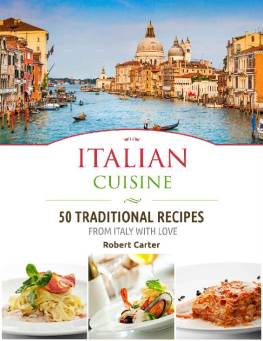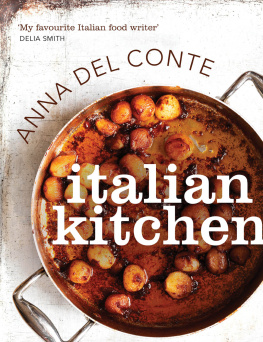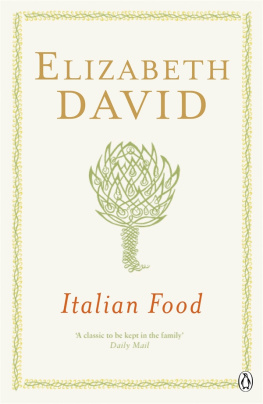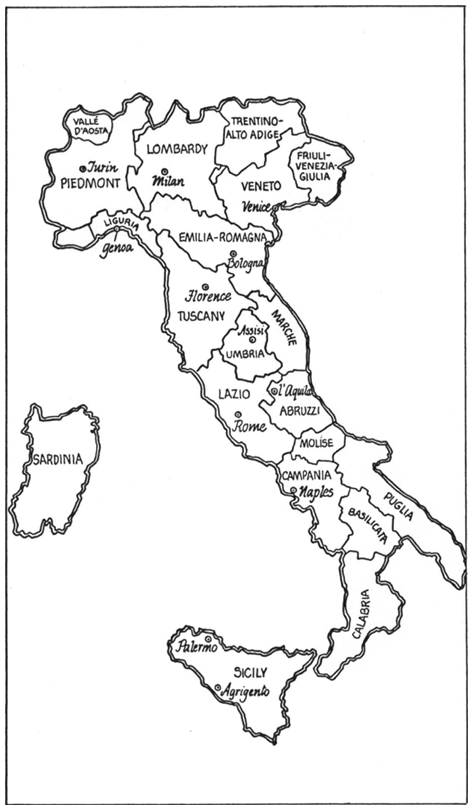THE REGIONAL ITALIAN KITCHEN
Published by M. Evans
An imprint of The Rowman & Littlefield Publishing Group, Inc.
4501 Forbes Boulevard, Suite 200, Lanham, Maryland 20706
www.rowman.com
Unit A, Whitacre Mews, 26-34 Stannary Street, London SE11 4AB
Distributed by NATIONAL BOOK NETWORK
Copyright 1978 by Nika Hazelton
Illustrations copyright 1978 by M. Evans and Co. Inc
First paperback edition 2015
All rights reserved. No part of this book may be reproduced in any form or by any electronic or mechanical means, including information storage and retrieval systems, without written permission from the publisher, except by a reviewer who may quote passages in a review.
British Library Cataloguing in Publication Information Available
Library of Congress Cataloging-in-Publication Data
The hardback edition of this book was previously cataloged by the Library of Congress as follows:
Hazelton, Nika Standen
The regional Italian kitchen.
Includes index.
1. Cookery, Italian. I. Title.
TX723.H37 641.5945 78-3717
ISBN 978-1-59077-498-4 (pbk. : alk. paper)
ISBN 978-1-59077-499-1 (electronic)
 The paper used in this publication meets the minimum requirements of American National Standard for Information SciencesPermanence of Paper for Printed Library Materials, ANSI/NISO Z39.48-1992.
The paper used in this publication meets the minimum requirements of American National Standard for Information SciencesPermanence of Paper for Printed Library Materials, ANSI/NISO Z39.48-1992.
Printed in the United States of America
For
Lois and Vincent Romei
and
Alessandro Morandotti
Best of Friends
Introduction
Italy today is an up-to-date, modern country with its full share of automobiles, latest appliances, supermarkets, modern kitchens, and a shortage of domestic help. Food has not escaped the onslaught of the twentieth century: most restaurants feature an all-Italy menu (pasta and veal, guaranteed to please all comers); lunch counters, the tavola calda (literally, the hot table), are set up in cafes, and along with espresso, you can have a sandwich or a quick dish of pasta or vegetables instead of sitting down to the time-honored, leisurely three-course meal.
Yet the tradition of superb and varied regional cooking has never been lost. Since the days when Italy was largely agricultural and the food was solid, flavorful, peasant cooking, this tradition has always been kept alive in the home. Even today, the cook still cooks basically what she has always cooked and what her mother cooked though her food will be less substantial and much lighter. Italians are individualists, fiercely attached to their native localities and to the cooking of their region. When left to myself, for instance, I cook Tuscan or Roman food, the remembered dishes of my Italian homes.
The recipes in this book have come from such home cooks. Some go back to my Italian childhood, some are from relatives, dispersed to all parts of the Italian peninsula. Others were gathered in my travels, given to me by friends, discovered in old cookbooks or in eating places in every region of Italy that still feature la cucina casalinga, home cooking of the region.
This is not a systematic or historical account of the traditional food of the Italian provinces, nor does it duplicate recipes found in most Italian cookbooks (ravioli, cannelloni, salt cod, and so forth). Rather, it concentrates on recipes not generally known in America. However, the dishes are not complicated or costly, and they dont require special ingredients. It is my hope that they will bring new tastes and variety to ordinary everyday cooking, while expressing to some degree the marvelous tastes and variety of the regions of Italy.
Like all cookbooks, this one reflects my tastes and those of the people I cook for, as well as my personal opinions based on the experience of traveling throughout Italy and keeping house each year in Tuscany among terraces of olives and vines.
Italian Regional Food
Broadly speaking, Italy is divided into two main culinary areas, with the basic flavor of each determined by the cooking fats used. The northern part uses butter, and olive oil is in secondary use. The southern part is the olive oil region, and butter is not often used, although a certain amount of lard in the cooking of the South gives it a characteristic flavor (for in stance, in Roman cooking).
Beyond this simple division, the regional food of Italy has been influenced by several factors that give each area its special taste: geography, history, economy. All the conquerors of different parts of the country have left their mark on the culture and the food of the regionsEtruscans, Romans, Arabs, Lombards, Goths, Normans, Spaniards, French, Austrians. The northern parts of Italy, with their abundant natural resources and economic advantages and their closeness to other parts of Europe, especially France and Austria, feature food that is much lighter, subtler, and more varied than that of the regions to the south, in the heel of Italy. The food of the South reflects its Greek origins, and in Sicily we still see the influence of the Arab conquest in the stuffed meats and vegetables, the sweets, the absence of pork. In the North, the herbs are sage and rosemary, applied with a light hand, and tomato sauces have a modest role in traditional cooking. In the South, garlic, basil, oregano and olives appear, and the tomato is ubiquitous. The bread and pasta foundation of all Italian cooking was laid by the Romans, who were large-scale wheat cultivators.
Most Italian regional cooking is more or less cooking, where specific quantities or even specific ingredients are not necessary to the same dish, and the same dish, incidentally, may have different names, even within the same region. Italian food varies from region to region not so much in the basic dishes as in the way they are put together and seasoned. Italy produces basically the same food products throughout the country: grains, vegetables, fruits, cheese, poultry, pork products and, along the coasts and in the lakes of the North, fish. Traditionally, meat did not figure largely in this country, for it had not been favored with much pasture land. Meat was the longed-for Sunday and holiday food. Now, because of the countrys comparative prosperity, Italy can import larger quantities of meat from abroad, and it is no longer a luxury food.
All these many influences produced a cookery throughout the country that stresses the individual flavors of the food and simple, very careful cooking. It also stresses fresh ingredients, freshly prepared. Italian food is not plastic, said a friend who visited Italy for the first time and was thrilled by the fresh seasonal foods.
Finally, all of Italy is one great vineyard, and wine is not simply a drink; it is part of the daily food of the country.
Piedmont
The cooking of Piedmont is substantial but restrained, and dignified like a citizen of the region. It is excellent, serious cooking, resembling French cookery (Piedmont and France border on each other). There is a courtliness to the food of Turin (the city of the former Italian royal family), which is credited with having invented the grissino, the bread stick, and where chicken is cooked la marengo, as in France (Napoleon had been in Turin).
The ample game of the mountains is marinated in red wine and spices; the famed braised beef, made with Barolo, one of the great wines of the region, is as carefully constructed as its French cousin, beef Bourguignonne. The







 The paper used in this publication meets the minimum requirements of American National Standard for Information SciencesPermanence of Paper for Printed Library Materials, ANSI/NISO Z39.48-1992.
The paper used in this publication meets the minimum requirements of American National Standard for Information SciencesPermanence of Paper for Printed Library Materials, ANSI/NISO Z39.48-1992.